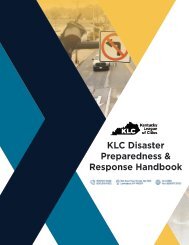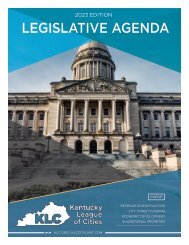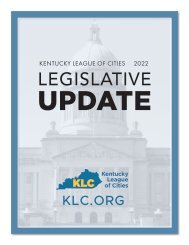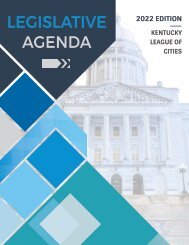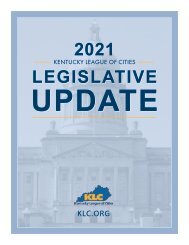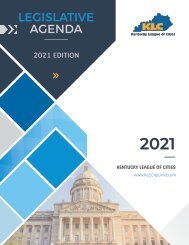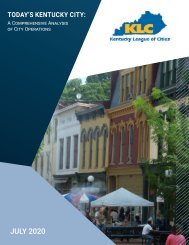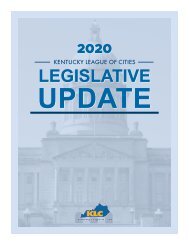KLC 2020 Legislative Agenda
Create successful ePaper yourself
Turn your PDF publications into a flip-book with our unique Google optimized e-Paper software.
Separating the governance of CERS from KERS will help
ensure the local pension system is free from political
influence, regardless of future administrations. Additionally,
it will guard against CERS being lumped into decisions that
are made for the benefit of the state's struggling system.
The KRS Board of Trustees is comprised mostly of
gubernatorial appointees and representatives of KERS,
even though it does not account for most of the assets or
members in KRS. CERS is growing and now has 242,185
members compared to 134,477 in KERS. That makes CERS 64
percent of the membership and KERS 32 percent. While KERS
lost 10,710 employees from Fiscal Year 2009 to Fiscal Year
2018, CERS reported an increase in employment numbers.
percent of the KRS Investment Committee and 14
percent of its Actuarial Subcommittee. That unfair
representation is one of the reasons those advocating
for separate governance believe it is necessary to
ensure decisions are made in the best interest of the
local pension system, regardless of the plight of other
systems managed by KRS.
Because CERS is 64 percent of KRS membership, it
pays 64 percent of its administrative expenses. Those
are continuing to climb every year and are much
higher than other state pension systems that run
independently of KRS.
CERS is a local pension system, made up of city,
county and school board employees (excluding
teachers). It is important for the municipal employees
who keep our cities safe and desirable places to live.
They maintain our city halls, parks and streets. These
members provide police and fire protection and create
an environment that drives economic development.
They deserve a pension system that is also safe and
secure; one that is managed by people who put their
needs and interests first.
The local pension system holds a large chunk of the funds
KRS manages, $13.4 billion compared to $4.4 billion in KERS.
Despite being 73 percent of KRS assets compared to the 27
percent held by KERS and SPRS, it is the KERS funding crisis
that drives decisions and discussions at KRS. Testimony
given by Eager before a May 2019 PPOB meeting on why KRS
wanted to change the funding formula for all the systems
it manages did not include any data on how such a move
would impact CERS.
CERS representation on the KRS Board ofTrustees accounts
for just six of the 17 seats - 35 percent. It makes up 11
Follow us on twitter @freeCERSky
PAGE 4 OF 14





